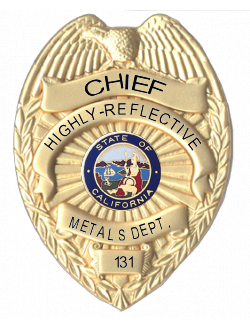(This entry originally appeared on WhatTheyThink.com on March 28, 2011)
I have taken a break from my work analyzing the Memjet printer (I know that everyone is waiting for more news on that, but this project took priority for a while) to do some photography for a federal agency. The project was to photograph some of the law enforcement badges used in the various agencies in this department. One of them is the Dept. of Highly Reflective Metals.
This was a nightmare assignment, one which most photographers shun because it’s so darned hard to do. I would rather photograph weddings than badges (not really). My first attempt was to place the badge on a white card, use soft overhead portable strobe light, and take a photo. Wrong, wrong wrong!
This was a catastrophe, and I should have seen it coming; I think I was being lazy. On my second attempt, I employed the right technology. I used three 640 watt-second Einstein strobe flash units, an isolation igloo from Photoflex, and a badge trapeze of my own construction – see below. I also added a white card suspended from a light stand with a hole cut in it to allow – only – the front element of my lens to show through. Reflections are your enemy with any form of jewelry photography, and badges are a particularly difficult type of jewelry because they are rounded on the front face, creating the opportunity to reflect everything in their environment including the camera, the lights, stands, and more.
This is one of the badges I photographed in my tent. You can see the trapeze of fishing line I used to suspend the badges in mid-air while photographing them.
So, isolating the badge in a white tent surrounded by a massive amount of light allowed me to get good depth of field, perfect illumination, and almost no reflections. My badge trapeze is nothing more than a pair of posts made of foam core with strands of fishing line stretched across between them. I suspended each badge on the fishing line, then put the trapeze into my igloo, and made the photos. Even with the fishing line support, I still had a tiny bit of retouching to do in Photoshop on each image. Exposure was not a problem; in fact I had to reduce the amount of light I was flashing into the igloo.
Here is the badge photography set-up. Note the white card with a hole cut in the middle to allow the lens to look through. On both sides are 640 ws Einstein strobe flash units. The tent is made by Photoflex, and it is great for small table-top photography where the objective is to remove all shadows.
I use the radio controls for my Einsteins, so controlling the lights is easy and extraordinarily accurate. The Cyber Commander radio controller allows me to adjust a single strobe lamp in 0.1 stop increments. I used the new Canon 100mm macro lens at f32 for most of my exposures, which ensured that everything on each badge was in perfect focus. On one of the badges I could not get a shot without disturbing reflections of the camera lens. I solved the problem by shifting the camera to the side, and shooting the badge about 10 degrees off-axis. Then I returned it to square in Adobe Photoshop using its geometric editing controls (distort and perspective). That worked perfectly.
Here is my advice to erstwhile badge photographers: proceed with caution! If you are careful, and if you set-up your photographic environment correctly, you will succeed. If I had it all to do over, I would rent a Canon shift-tilt lens for this project. These lenses allow the camera to be moved left or right (or any direction), and then the image shifted by virtue of the mechanical shift mechanism of the lens. This would make it possible to avoid the direct reflection of the lens on the badge faces. I have to go now to enforce the law for the Department of Highly-Reflective Metals. Back soon!




